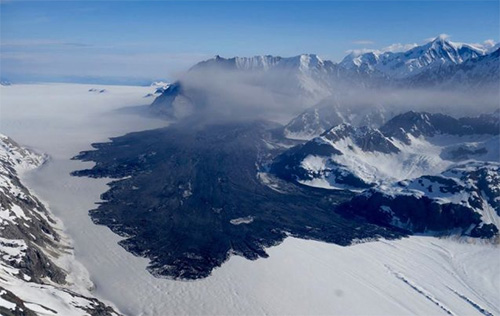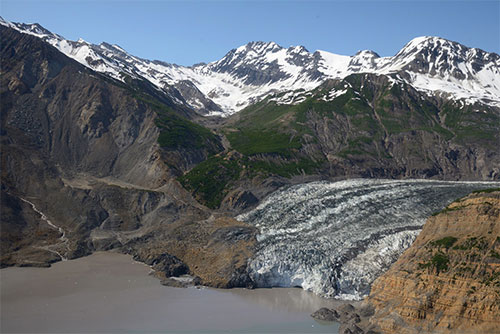
Massive Landslide Detected in Glacier Bay’s Fragile MountainsBy STACY MORFORD
July 04, 2016
The sliding rock stopped a few miles short of the inlet this time. Last fall, when a similar-sized landslide landed directly in Alaska’s remote Taan Fiord, scientists discovered that it created a tsunami wave so large, the water swept 600 feet up the opposite side of the fiord, stripping away the trees.
A pilot captured this image of the landslide in Glacier Bay National Park that Columbia University scientists had detected from seismic waves.
Large landslides often go unnoticed in remote areas, but they shake the earth enough to create seismic waves that have been catching the attention of Stark, seismologist Göran Ekström and their colleagues at Lamont. Stark and Ekström’s preliminary analysis of the Glacier Bay landslide, which had a 5.2 magnitude, suggests the collapse started at 8:21 a.m. local time on June 28, 2016, when a rock face estimated to have been about half a square mile in size collapsed on a high, steep slope. The rocky debris appears to have accelerated for almost a minute over about a mile and a quarter, Stark said. Once it hit the ice of Lamplugh Glacier, the debris kept sliding, pushing up snow and ice as it moved. A pilot who later landed near the end of the landslide, about six miles from the collapse site, found that the thickness of the debris there was more than twice the height of a man. Once the clouds clear and satellite images become available, the scientists will be able to calculate the volume of the Glacier Bay collapse. From their seismic analysis, Stark and Ekström estimate the landslide to have been about 120 million metric tons – the equivalent of some 60 million mid-size SUVs tumbling down a mountainside. Fragile landscapes The Alaska coast is particularly fragile. The region is geologically active, with mountains being pushed up as tectonic plates move. It also is being eroded by glaciers. Glaciers once filled the valleys, and their weight packed glacial-marine sediment into rock that now makes up the valley walls. As the glaciers retreat, the ice that once buttressed the valley walls disappears, leaving rock faces that tend to be weak and prone to collapse. In Taan Fiord, the scientists found evidence of other landslides in the past. The ice retreat has been quick there – as recently as 1961, Tyndall Glacier, now at the edge of the collapse site, had extended to the edge of Icy Bay, 15 miles down the fiord. As the scientists and their colleagues zoomed in on images of Lamplugh Glacier and the inlet walls around Glacier Bay this week, they pointed out signs of past landslides there, as well. “It’s pretty much the same geology. It’s just a matter of time and space when another landslide will strike,” Stark said. “The thing that really got me: If it just happened a bit further over, near the calving front, that would be a very bad thing. You can see in Google Earth – that’s a cruise ship right there. If the landslide had been closer, it likely would have dumped some debris in the inlet.” The landslide in Taan Fiord landed partly on the toe of Tyndall Glacier and largely in the water. Scientists are studying the geology and the shape of the fiord to better understand landslide and tsunami risks.
The scientists have been studying the geology of the fiord and measuring the trim line along the edges where the tsunami wave stripped away the trees and scattered them like match sticks. Colleagues from other universities, the National Park Service, and U.S. Geological Survey are looking at other aspects, including the types of sediment carried by the tsunami wave and the influence of the shape of the fiord below the water line. Pat Lynett of the University of Southern California has been working on modeling how the fiord’s shape would have affected the behavior of the tsunami. “Putting this in geological context is really important,” Stark said. “These walls are failing by the very nature of the process.” Seismic wiggles Stark and Ekström have been developing a technique for the past seven years that allows them to detect large landslides by picking out their signature in the stream of seismic data created by earthquakes and other activity around the world. The details they are able to extract could one day help governments sound tsunami warnings, help rescuers find landslide-struck villages faster, and warn of risks such as landslide-dammed rivers that could soon burst through. While earthquakes tend to start abruptly, the seismic waves generated by a landslide start gradually, then accelerate as the mass moves down the mountain, and finally decelerate. The scientists and their colleagues in the Global CMT Project at Lamont work backwards from that data, using models of how seismic waves are generated and how they travel over the Earth’s surface, to determine the forces that were involved. Once the scientists estimate the landslide mass, they can determine the landslide’s acceleration and velocity, and from there they can determine its distance and motion. Glacier Bay has had other spectacular landslides, including one in 2014 on Johns Hopkins Glacier. According to USGS reports, a large earthquake in 1958 triggered a landslide in Lituya Bay, on the coast, which generated a tsunami that killed two people in a fishing boat.
Related Articles:
Edited by Mary Kauffman, SitNews
Source of News:
Representations of fact and opinions in comments posted below are solely those of the individual posters and do not represent the opinions of Sitnews.
|
||

